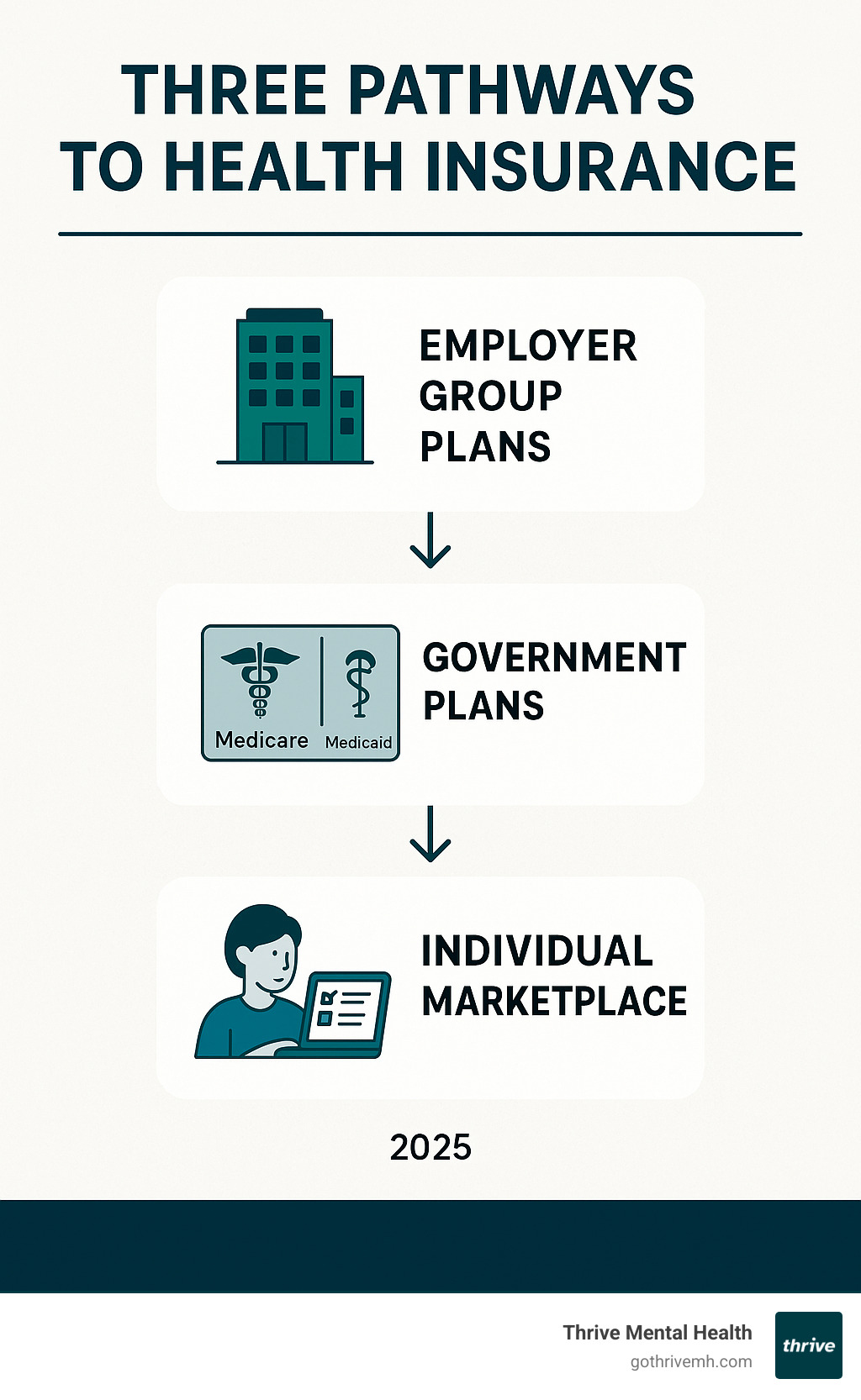Insure Your Health, Not Your Confusion – A Fun Guide to Individual Health Insurance

Why Individual Health Insurance is Your Financial Safety Net
Individual health insurance is coverage you purchase for yourself and your family, separate from an employer or government plan. It’s a crucial financial tool for many.
Key Facts About Individual Health Insurance:
- Who needs it: Self-employed, freelancers, gig workers, those between jobs, and early retirees.
- Where to buy: The Health Insurance Marketplace, directly from insurers, or through brokers.
- When to enroll: During Open Enrollment (Nov. 1 – Jan. 15) or a Special Enrollment Period after a major life change.
- Average costs: $456/month for individuals, $1,152/month for families (2020 data).
- What it covers: 10 essential health benefits, including mental health services, prescriptions, and preventive care.
Whether you’re a freelancer, a recent grad, or between jobs, individual health insurance protects you from medical bills that could derail your finances. Without coverage, a single ER visit can cost thousands, but the right plan provides access to routine check-ups and specialized mental health care.
Thanks to the Affordable Care Act, you can’t be denied coverage for pre-existing conditions, and many people qualify for subsidies that lower premiums. The average person receiving federal subsidies pays about $80 per month.
I’m Nate Raine, CEO of Thrive Mental Health. With over a decade of experience in healthcare, I’ve seen how the right individual health insurance plan is often the key to accessing timely mental health support.

What is Individual Health Insurance and Why Is It Your Lifeline?
Imagine needing emergency surgery. Without individual health insurance, the bill could be astronomical. This coverage is your financial lifeline against unpredictable medical costs.
Individual health insurance is a contract where you pay a monthly premium to an insurer, and they agree to cover a portion of your medical expenses. It’s a reliable way to manage healthcare costs.

Thanks to the Affordable Care Act, every plan must cover a set of Essential Health Benefits. These include doctor visits, prescription drugs, mental health services, and emergency care. This coverage protects both your health and your financial future by making care more accessible and affordable. For more details, see this quick guide to the Health Insurance Marketplace®.
Who Needs a Personal Health Plan?
Anyone without health insurance through a job or government program should consider an individual plan. This is especially true for:
- Self-employed individuals: Freelancers, contractors, and small business owners must secure their own coverage.
- Gig economy and part-time workers: Those in roles that don’t offer benefits are responsible for their own insurance.
- Students and early retirees: Students over 26 who are no longer on a parent’s plan and retirees under 65 (before Medicare eligibility) need coverage.
Certain life events—like losing job-based coverage, getting married, or having a baby—may qualify you for a Special Enrollment Period outside the standard enrollment window, providing an opportunity to get covered.
The Key Benefits of Having Your Own Coverage
Having your own individual health insurance plan offers several crucial advantages:
- Financial Security: Predictable costs (premiums, deductibles) replace the risk of massive, unexpected medical bills, protecting your savings.
- Access to Care: Insurance makes you more likely to seek preventive care and address health issues early, including vital mental health support. At Thrive Mental Health, we help clients steer their plans, such as Navigating Mental Health Support with Aetna and UnitedHealthcare.
- Preventive Services: Most plans cover annual physicals, vaccinations, and cancer screenings at no extra cost, helping you stay healthy.
- Prescription Drug Coverage: This benefit makes medications affordable, which is essential for managing both acute and chronic conditions.
- Chronic Condition Management: Insurance ensures consistent access to specialists and treatments for conditions like diabetes or asthma.
- Peace of Mind: Knowing you’re protected from worst-case scenarios allows you to focus on living your life without constant financial worry.
Cracking the Code: Plan Types and Coverage Tiers

Shopping for individual health insurance can feel complex due to various acronyms and tiers. However, understanding the basics of plan networks, cost-sharing, and flexibility makes it much simpler. Let’s break down the key components so you can choose with confidence.
| Plan Type | Network Size | Need Referrals? | Out-of-Network Coverage | Best For |
|---|---|---|---|---|
| HMO | Smaller | Yes | Emergency only | Lower costs, don’t mind referrals |
| PPO | Larger | No | Yes (higher cost) | Maximum flexibility |
| EPO | Medium | No | Emergency only | Balance of cost and flexibility |
| POS | Medium | Yes | Yes (higher cost) | Want some flexibility with lower costs |
The Alphabet Soup: HMO, PPO, EPO, and HSA-eligible Plans
Each plan type dictates how you access doctors and specialists.
-
Health Maintenance Organization (HMO): These plans often have lower costs. You choose a primary care physician (PCP) who manages your care and provides referrals to in-network specialists. Except for emergencies, there is no coverage for out-of-network care. HMOs were chosen by 49% of unsubsidized customers in 2020.
-
Preferred Provider Organization (PPO): PPOs offer the most flexibility. You can see any doctor or specialist, in or out-of-network, without a referral. However, you’ll pay more for out-of-network care, and premiums are generally higher.
-
Exclusive Provider Organization (EPO): An EPO is a hybrid. You don’t need referrals to see in-network specialists, but there’s no coverage for out-of-network care (except emergencies). EPOs attracted 33% of unsubsidized customers in 2020.
-
Point of Service (POS): A POS plan combines HMO and PPO features. You typically need a PCP and referrals, but you have the option to go out-of-network for a higher cost.
-
Health Savings Account (HSA)-eligible plans: These aren’t a plan type but a feature of high-deductible health plans (HDHPs). An HSA allows you to save pre-tax money for medical expenses. The funds are yours to keep and roll over each year, offering a triple tax advantage (tax-free contributions, growth, and withdrawals for medical costs). Learn more about what health savings accounts are.
Understanding the Metal Tiers for Individual Health Insurance
The metal tiers—Bronze, Silver, Gold, and Platinum—determine how you and your insurer split costs. The quality of care is the same regardless of the tier.
-
Bronze: Lowest monthly premium, but you pay more when you need care (about 40% of costs). Best for healthy individuals who want protection from major medical events. Bronze plans were the most popular choice (42%) for unsubsidized customers in 2020.
-
Silver: Moderate premiums, with insurance covering about 70% of costs. Crucially, Silver is the only tier eligible for cost-sharing reductions (CSRs), which lower your deductible and copays if your income qualifies. Silver plans captured 34% of selections in 2020.
-
Gold: Higher monthly premiums, but lower out-of-pocket costs (insurance covers about 80%). A good choice if you expect to use medical services regularly.
-
Platinum: Highest premiums and lowest out-of-pocket costs (insurance covers about 90%). Ideal for those with significant healthcare needs who want predictable expenses.
-
Catastrophic: Available to people under 30 or with a hardship exemption. These plans have very low premiums but extremely high deductibles. They protect against worst-case scenarios but don’t cover much routine care and aren’t eligible for premium tax credits.
When comparing plans, consider your expected healthcare usage. For help comparing specific insurers, you might find insights in articles like Which is Better for You: Aetna or UnitedHealthcare?.
What’s Actually Covered? A Look Inside Your Policy
So, what does your individual health insurance policy cover? Thanks to the Affordable Care Act (ACA), all Marketplace plans must include a core set of Essential Health Benefits.

This foundation ensures you’re covered for a wide range of services, including:
- Ambulatory patient services (outpatient care)
- Emergency services and hospitalization
- Maternity and newborn care
- Mental health and substance use disorder services
- Prescription drugs
- Rehabilitative services
- Laboratory services
- Preventive and wellness care
- Pediatric services, including oral and vision care
This required coverage means your plan supports your overall well-being, not just emergencies. We cover all aspects of Insurance at Thrive Mental Health to help you maximize these benefits.
Mental Health Coverage: A Non-Negotiable Benefit
Mental health coverage is a fundamental part of every individual health insurance plan. The Mental Health Parity and Addiction Equity Act requires that mental health services be covered at the same level as physical health services. This means your insurer cannot charge higher copays or impose stricter limits on mental health care.
This parity ensures access to comprehensive support, including:
- Inpatient and outpatient services, like our IOP and PHP programs.
- Substance use disorder treatment.
- Counseling and psychotherapy, including effective online therapy options as shown in studies on internet-based CBT.
Major insurers are embracing this evolution, as seen in how Blue Cross Blue Shield is Changing Healthcare with Innovative Solutions. Your plan is designed to support your complete well-being.
The Deal with Pre-Existing Conditions
Thanks to the ACA, insurers can no longer deny you coverage, charge you more, or refuse to cover treatment for pre-existing conditions. Whether you have diabetes, asthma, or a mental health condition, you are guaranteed access to comprehensive coverage through Marketplace plans. This protection has made individual health insurance accessible to millions. For more information, visit the Health Insurance Marketplace®.
Beyond the Basics: Dental, Vision, and Paramedical Services
While Essential Health Benefits are comprehensive, some services may require separate coverage.
- Dental and Vision: Adult dental and vision care are often sold as separate add-on policies. However, pediatric dental and vision care are included as an Essential Health Benefit.
- Paramedical Services: Coverage for services like chiropractic care, massage therapy, or acupuncture varies significantly between plans. If these are important to you, check the plan details carefully.
Always review a plan’s Summary of Benefits and Coverage (SBC) to understand exactly what’s included. You can explore different plan offerings through resources like A Comprehensive Guide to Aetna, Florida Blue, and Evernorth Plans.
The Bottom Line: Navigating Costs and Finding Your Plan
Understanding the costs of individual health insurance is key to making a smart decision. Let’s break down the main components.

- Premium: Your fixed monthly payment to keep your plan active. The average premium in 2020 was $456 for individuals and $1,152 for families.
- Deductible: The amount you must pay for covered services before your insurance starts paying. The 2020 average was $4,364 for an individual plan.
- Copayments & Coinsurance: After meeting your deductible, you’ll pay either a flat fee (copay) or a percentage of the cost (coinsurance) for services.
- Out-of-Pocket Maximum: The most you’ll have to pay for covered services in a year. After you reach this limit, your insurance pays 100%.
Factors That Influence the Cost of Individual Health Insurance
Several factors determine your premium:
- Age: Older adults typically pay more than younger ones.
- Location: Healthcare costs and insurance rates vary by state and county.
- Tobacco Use: Smokers can be charged up to 50% more.
- Plan Tier: Bronze plans have lower premiums and higher out-of-pocket costs, while Platinum plans are the opposite.
- Dependents: Adding a spouse or children will increase the premium.
- Subsidies: Based on your income, you may qualify for premium tax credits or cost-sharing reductions that significantly lower your costs. You can learn more about how much health insurance costs.
How and Where to Apply for Your Plan
The Health Insurance Marketplace at Healthcare.gov is the primary place to compare plans, check for financial aid, and enroll. The main enrollment window is the Open Enrollment Period (Nov. 1 – Jan. 15). If you miss it, you may qualify for a Special Enrollment Period after a major life event like losing a job or getting married.
You can also buy plans directly from insurance companies or with the help of an insurance broker, though you can only get federal subsidies through the Marketplace. The application requires basic personal, household, and income information. Once you choose a plan, make your first premium payment to activate coverage. If exploring government options, you might also want to learn about Medicaid Covered Therapy.
Frequently Asked Questions about Individual Health Insurance
Let’s tackle some common questions about individual health insurance.
What if I miss the Open Enrollment deadline?
If you miss the Nov. 1 – Jan. 15 Open Enrollment window, you still have options. A Qualifying Life Event, such as losing job-based coverage, getting married, or moving, triggers a 60-day Special Enrollment Period to sign up for a plan. Additionally, you can apply for Medicaid or CHIP at any time of the year if your income qualifies. Short-term health insurance plans are another option, but use them with caution. They are not ACA-compliant and typically don’t cover pre-existing conditions, essential benefits, or mental health services, leaving you with significant coverage gaps.
Are there plans with guaranteed acceptance or no medical questions?
Yes. All individual health insurance plans sold on the ACA Marketplace have guaranteed issue. This means insurers cannot deny you coverage, charge you more, or refuse to cover treatments based on your health history. There are no medical exams or health questions on the application. This protection is a cornerstone of the ACA and ensures everyone can get coverage, which is especially vital for accessing mental health care. This differs from short-term plans, which can deny you based on your health. For more details, you can review information from major carriers like UnitedHealthcare.
How do I choose the absolute best plan for my budget and needs?
Finding the right individual health insurance plan involves balancing cost with your specific needs. Follow these steps:
- Assess your healthcare needs. Consider how often you see a doctor, if you have chronic conditions, or if you need regular prescriptions. Prioritize what’s important, such as robust mental health coverage for therapy or intensive programs like those at Thrive Mental Health.
- Compare total costs, not just premiums. Look at the deductible, copays, and out-of-pocket maximum to understand your potential financial exposure. A low-premium plan might cost you more if you need frequent care.
- Check the provider network. Ensure your preferred doctors, hospitals, and specialists are in-network to avoid high out-of-network charges, especially with HMO and EPO plans.
- Review the drug formulary. If you take prescription medications, check the plan’s list of covered drugs (formulary) to confirm your medications are included and affordable.
- Read the details. Use the comparison tools on Healthcare.gov and review the official Summary of Benefits and Coverage (SBC) for each plan you consider. The “best” plan is the one that fits your unique health and financial situation.
Conclusion
We’ve journeyed through individual health insurance, from decoding plan types like HMOs and PPOs to understanding the financial protection offered by the different metal tiers. The most important takeaway is this: individual health insurance is your ticket to freedom—freedom from worry about devastating medical bills and the freedom to get the care you need, when you need it.
Solid coverage allows you to live fully. You can address physical and mental health concerns without hesitation, focusing on your goals instead of “what if.”
Thanks to mental health parity laws, your plan must treat mental health with the same importance as physical health. At Thrive Mental Health, we see daily how proper insurance opens the door to life-changing support. It’s often the critical first step on the path to wellness.
Your health, in every sense, is your most valuable asset. Take the time to find the right individual health insurance plan for your needs and budget. If you need help understanding your mental health benefits, our team can help you steer resources from providers like Cigna and UnitedHealthcare. You deserve comprehensive care that supports your whole self.